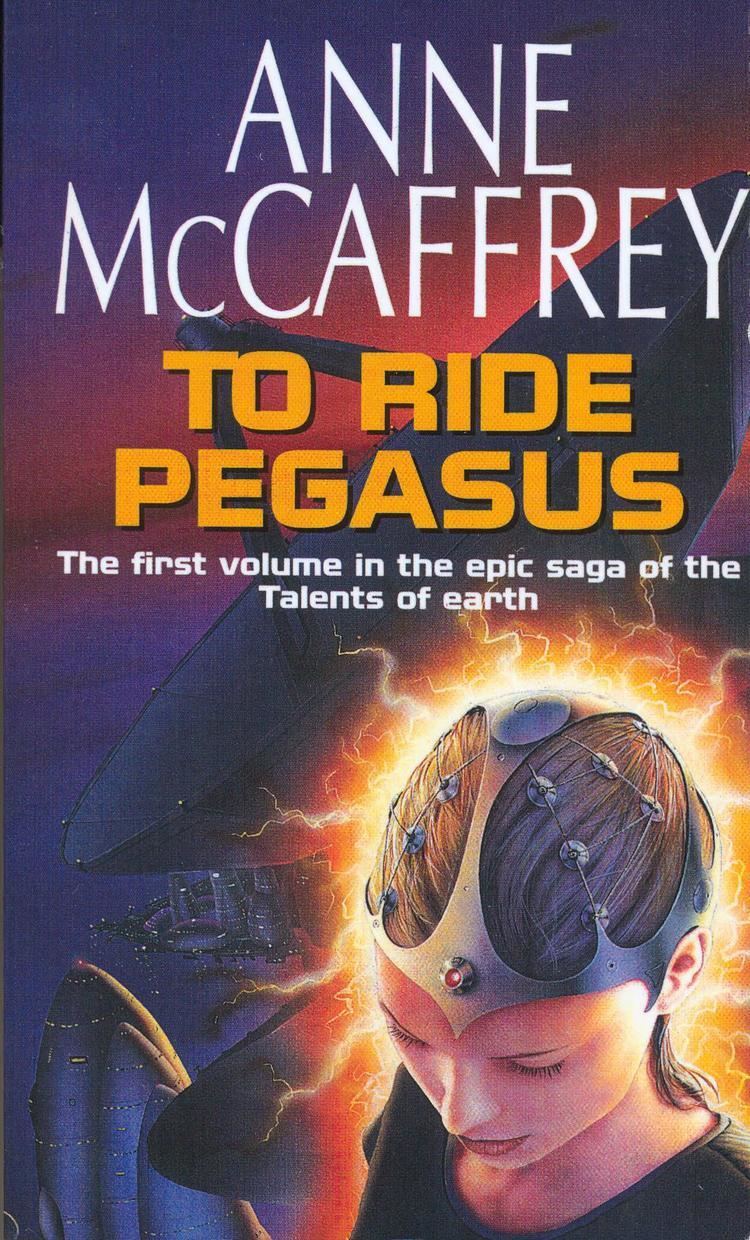8 /10 1 Votes8
Country United States Publication date August 1973 Pages 243 pp Originally published August 1973 Genre Science Fiction | 4/5 Goodreads Language English Media type Print (Paperback) ISBN 0-345-23417-0 | |||||||||||||||||||||||||||||||||
 | ||||||||||||||||||||||||||||||||||
Similar Anne McCaffrey books, The Talents Universe books, Science Fiction books | ||||||||||||||||||||||||||||||||||
Books i ve reread to ride pegasus by anne mccaffrey
To Ride Pegasus is a collection of four science fiction stories by Anne McCaffrey, published by Ballantine Books in 1973 and later under its Del Rey imprint. Alternatively, "To Ride Pegasus" is a novella, the first chapter of the book, and the one of four stories that was original to the collection.
Contents
To Ride Pegasus originates the fictional premise of the Talents universe, the setting for seven novels published 1990 to 2000: two more "Pegasus" books and five "Tower and Hive" books. All eight books feature so-called Talents, people with psionic powers such as empathy, telepathy, teleportation, telekinesis, clairvoyance, precognition, and the ability to find what is lost ('finders').
Pegasus is a symbol for Talent, early adopted by Henry Darrow: "You'd see a lot from the back of a winged horse ..." (p. 11). "When you ride the winged horse, you can't dismount. ... We'll find our bridle, I think, with time and training and more practice at riding".
Novella
The novella "To Ride Pegasus" is a prequel to the three previously published stories. It explains the fortunate scientific discovery of psionic powers and the earliest establishment of the Talents in human society, in Greater New York late during the 20th century. The 'precog' Henry Darrow does not avoid his own foreseen automobile accident. In the hospital, a talented nurse notices his unusual electroencephalograph (EEG) recordings and they complete the discovery together. Darrow recognizes the crucial breakthrough:
Now we can prove parapsychic powers exist and who has them. We can discredit the charlatans and clowns who've given the rest of us a bad name. The real Talents will be registered with the Center and we'll have graphs to prove they've had valid Incidents. The Center will supply them with the specialized jobs that utilize their Talents.
Darrow turns from high-price consultation about the future (astrology) to his lifework, setting the Talents surely on the way to a personally respected, legally protected, and highly paid status. Important early tasks are demonstration of scientific validity and detectability, private fund-raising, and creation of a coordinating and protective institution.
Darrow comes to direct the nonprofit North American Center for Parapsychic Talents. In his lifetime the Center identifies many Talents and begins to train them and place them in appropriate jobs. It secures a sheltered but conveniently located headquarters: a research, public relations, and residential campus. Darrow recognizes his successor as Director. He envisions crucial steps in the professionalization of Talents but their achievement is left to the future.
Collection
The three older stories feature the Center and its community of resident Talents, under Darrow's successor Daffyd op Owen. Each one features particular Talents, active or latent, within or without the community, but the big picture the continuing establishment of Talents in society by internal reform, social education, and legislation. Owen, his staff, and public officials are important players and the play is about recruitment, training, registration, public education, professional ethics and liability.
"A Womanly Talent", Analog, Feb 1969
The campaign to win professional immunity for Talents is underway with a comprehensive Bill under consideration by a committee of the US Senate. The story at the Center features a young husband and wife who soon win permission to reproduce. Lajos is a precog specialist in fires; he is employed privately by the insurance industry and works with the Center to prevent or mitigate public disasters. Ruth's talent is barely detectable and unknown in nature."Apple", Crime Prevention in the 30th Century, ed. Hans Stefan Santesson, Walker & Co., 1969
The Bill providing comprehensive legal protection for Talents is now expected to pass in a few weeks. The story at the Center concerns a theft by teleportation from a Manhattan department store window, which is undeniably the work of some unknown Talent. Relations between the Center and Law Enforcement are strained at best and public relations disaster may be anticipated."A Bridle for Pegasus", Analog, Jul 1973
Ethnic tension is high in Greater New York and a summer of strife is feared. The story at the Center concerns another wild Talent, a musical performer unaware of her ability to manipulate the emotions of a crowd. She might be registered and trained by the Center, or recruited by the leader of one ethnic faction, or even kidnapped.Series
During the 1990s McCaffrey made To Ride Pegasus the first book in a series that is otherwise set after greater psionic talents have been discovered or developed and their employment has become vital. Pegasus in Flight (1990) and its sequel Pegasus in Space show how the Talents enabled human society to extend beyond planet Earth, primarily by assisting space transportation and communication. The Rowan (1990) takes up the Talents and the author's second published story, "The Lady in the Tower" (1959), to initiate the Tower and Hive subseries. Essentially, the title character, the Rowan, is both a Talent and the lady in the tower. The books feature three generations of the most powerful Talents when human society is far-flung in the galaxy and interacts with alien interstellar species.
The Internet Speculative Fiction Database catalogues "The Talents Universe" in two subseries.
Talents
Tower and Hive
"The Lady in the Tower", The Magazine of Fantasy and Science Fiction, Apr 1959"A Meeting of Minds", The Magazine of Fantasy and Science Fiction, Jan 1969